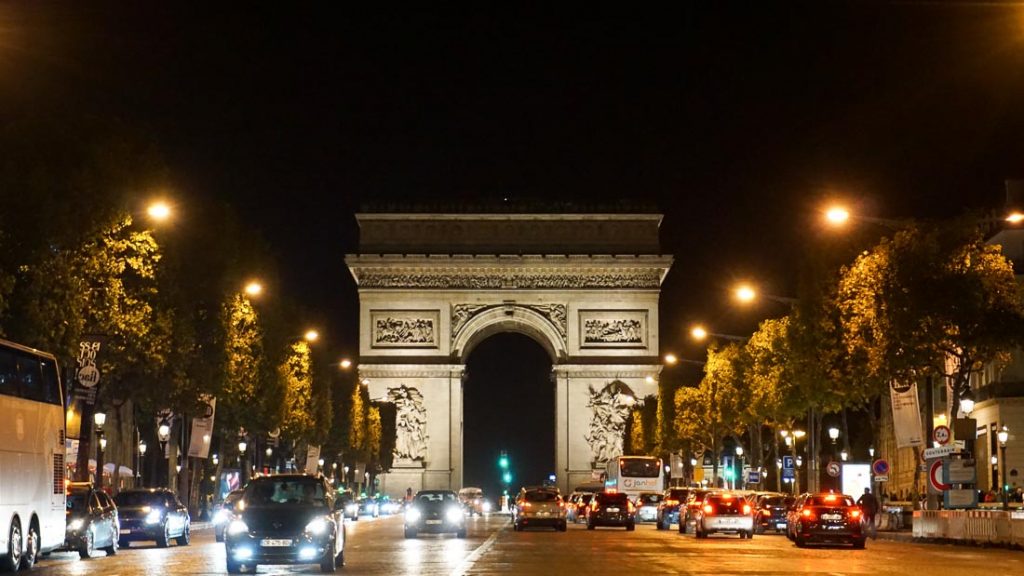After our South-East European winter tour of Slovenia, Italy, Greece, Albania and Montenegro, we proposed this year’s winter treat to be a tour of South Western Europe, namely France and the Iberian Peninsula, however, we have found so much to do and enjoy in France that we haven’t made it to Spain yet to see the all the Landmarks in Spain, which are one of the most famous European Landmarks. Trust me, we won’t be letting all our homework and trip planning go to waste, we’ll be catching up with Spain and its Iberian neighbours next year if not before.
So in the meantime, I have asked my travel blogging colleagues on the internet to give us all some tasters of great Spanish Landmarks. Spain today, not only has some of the most dramatic landscapes and charming little towns, each with its sparkling fountain in the Plaza Mayor, but Spain also has a fantastic legacy to display both as a historic Imperial centre in its own right and also as the cultural and religious meeting point between Islamic influence from Morocco and the fabulous power of Spanish Catholic Church in the middle centuries of the second Millenium.
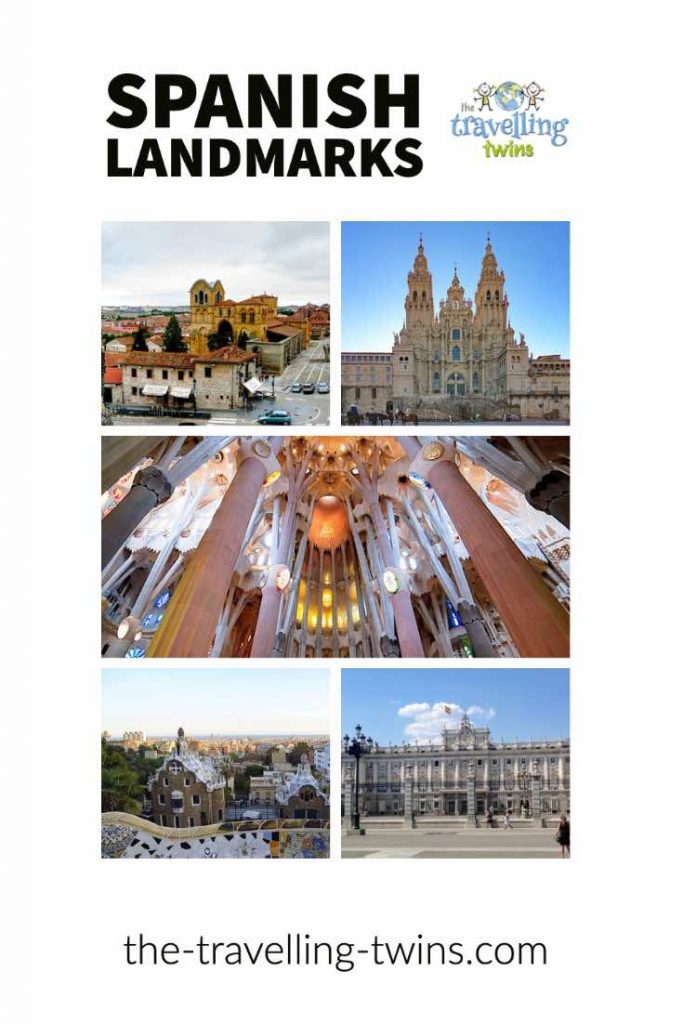
The famous Sagrada Familia in Barcelona
La Sagrada Familia is the dream of a great architect – Antoni Gaudi, almost made real, why almost? as the cathedral haven’t been finished yet. Even not finished Sagrada Familia is not only the most famous landmark in Spain but as well in Europe. It’s a church which is more consider a tourist attraction than a church.
Gaudi referred to ancient art, looking for inspiration in Catalan Gothic and medieval symbolism. However, this was not the end – the temple was supposed to be one living organism, and its elements referred to nature. Each of them was created separately and could not be identical.
Sagrada as the embodiment of Nature – God’s greatest work – contains symbols referring to four “kingdoms”: plants (stone forest of columns), animals (ornaments), minerals (stained glass) and man (sculptures and columns symbolizing ribs).
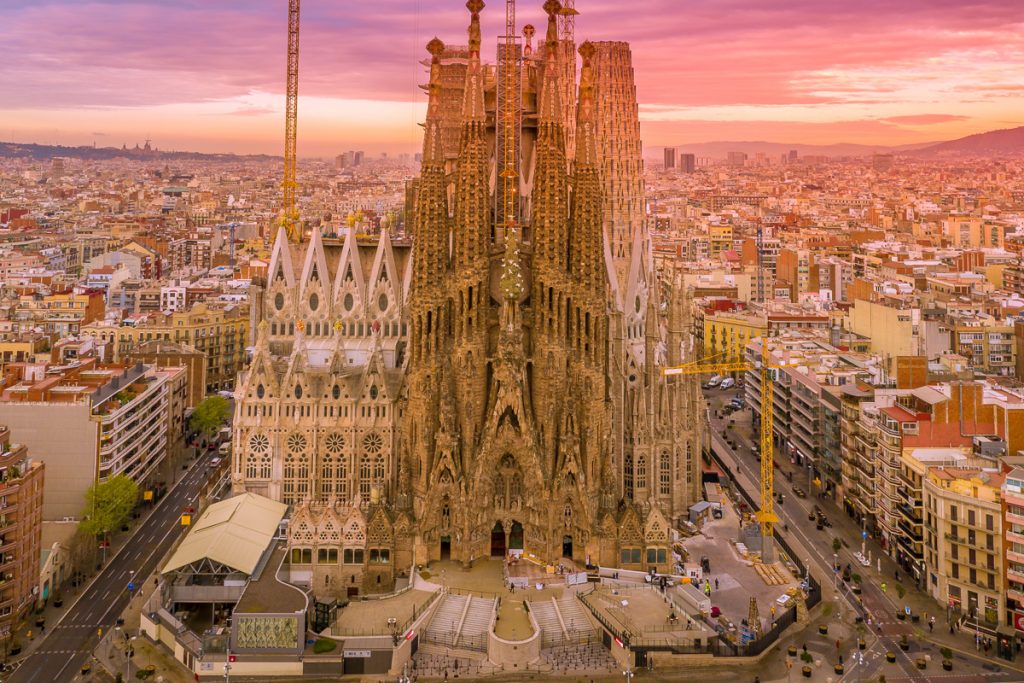
The whole is to be crowned with 18 towers that symbolize the apostles, evangelists, Mary and Christ. The façades of Nativity, Passion and Glory also refer to Jesus’ life. Learn more fact about Sagrada Familia.
Antoni Gaudi worked on the temple for over forty years. In the last years of his life, Gaudi only concentrated on Sagrada and has not undertaken any other projects. He moved to the construction site and stopped taking care of himself, directing all his energy towards work. Unfortunately, it was his personal work then when he died his assistant couldn’t finished the design, hence the Cathedral is not finish. Nowadays, computers have been used to help recreate the vision of the great architect. The construction is scheduled to be completed in 2026
In 2005, the elements of the church created by Gaudi were inscribed on the UNESCO World Heritage List. Church of St.
Contributed by Ania from The Travelling Twins
Park Guell Barcelona
A renowned landmark in Barcelona, Park Güell is one of the most beautiful public parks in the world. Located in the Gracia district, this venue is known for its incredible mosaics and the colorful salamander that graces one of the staircases (Nicknamed “el drac,” a salamander is also a symbol of Barcelona).
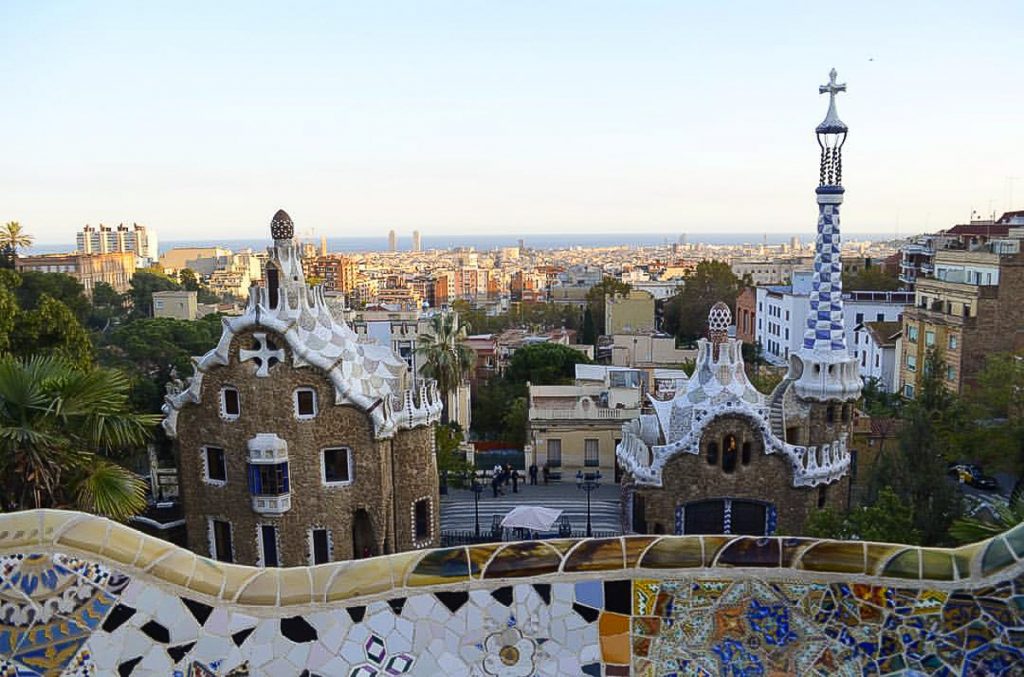
Designed as a modern housing estate by the famous Catalan architect Antonio Gaudi for the wealthy residents of Barcelona, Park Guell was built between 1900 and 1914. The park was named after Eusebi Guell, a patron of the park who commissioned Gaudi to do the job and opened as a public space in 1926.
Gaudi designed the Park Guell, as space where man and nature would coexist in harmony, and if you look closely, you will see that the park has a lot of curves and lacks straight lines – a testament to Gaudi’s commitment to his idea.
Today, Park Guell gets about 12 million tourists per year. Perched on the hill, Park Guell offers spectacular views of the city and the Mediterranean Sea and attracts visitors from all over the world.
If you plan on visiting other landmarks in Barcelona, you might want to know that the entrance to Park Guell is free when you purchase the City Pass.
Contributed by Daria from the Discovery Nut
The Tibidabo Cathedral
If you like visiting monuments, be sure to visit the Church of the Heart of Jesus (Temple Tibidabo) – Temple Expiatori del Sagrat Cor, which is located on a hill. The design of the building is the work of the Catalan architect Enric Sagnier, who was inspired by Sacre-Coeur basilica in Paris. The church is topped with a statue of Jesus with his arms outstretched and closely resembles the Christ statue that is found in Rio de Janeiro.
Entrance to the Tibibado Cathedral is free but the lift to the top costs 2.00€
Casa Batlló and Casa Mila – Barcelona
When you will be in Barcelona – you must keep two points in your mind. You must not miss a football match if Lionel Messi plays. And you should keep an eye for the works of Anthony Gaudi; wherever you travel in Barcelona, you will notice the divine touch of Anthony Gaudi everywhere, such is his influence on Barcelona.
A 5 minutes walk from the famous and busy Plaça de Catalunya will take you in front of Casa Batlló (known as Casa dels ossos locally), a masterpiece of Anthony Gaudi. It was an old building until Anthony Gaudi redesigned it in 1904. This colorful building looks like a human skeleton and skull from outside. There is a museum inside, you can explore the interiors with a fee (Euro 15 for the residents of Spain, Euro 25 for the foreigners).


If you walk for only 2 minutes from Casa Batlló, you will find another beautiful building and would easily understand that it’s yet another creation of the maestro I mentioned so many times here. It’s Casa Milà (known as La Pedrera locally), a UNESCO World Heritage Site and the last residence building designed by Anthony Gaudy. It looks like a stone quarry from outside. Like Batlló, you can also explore inside of Casa Milà with a fee.
Both of these architectures are examples of Art Nouveau and must things to see in Barcelona.
Contributed by Fuad Omar from A Walk in the World
San Juan de Gaztelugatxe
Gaztelugatxe is an islet in the coast of Bizcaya in the Basque Country (Northern Spain), approximately 1h drive from Bilbao. San Juan de Gaztelugatxe (or Gaztelugatxeko Doniene in Basque) is actually the small hermitage located on top of the rocky islet, dating back to the 10th century and dedicated to Saint John the Baptist.
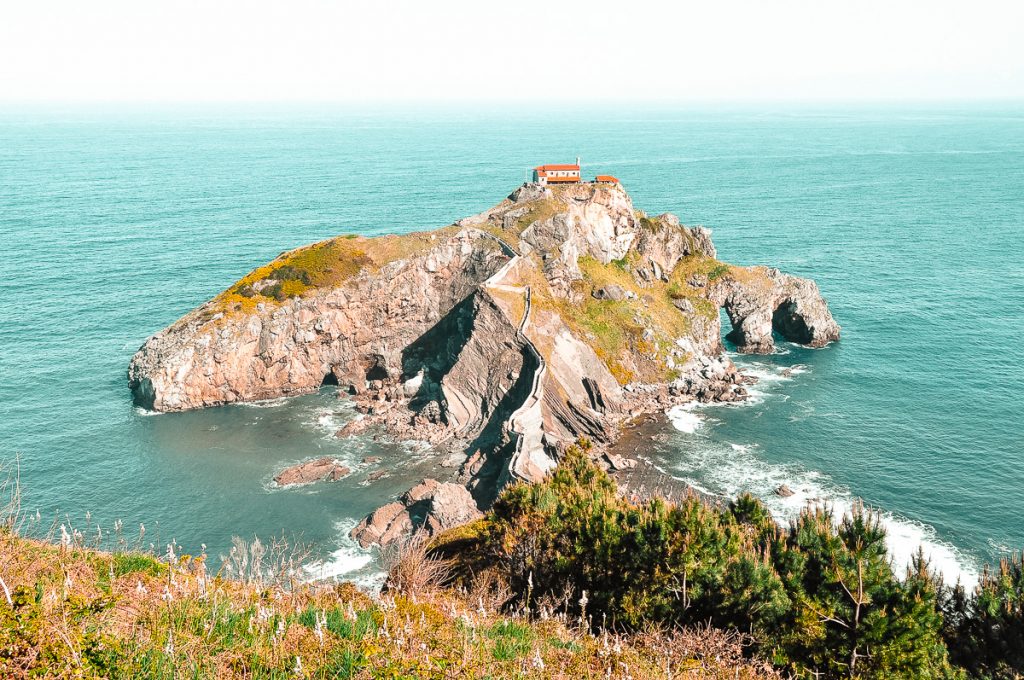
In order to visit it, you’ll have to park in the mainland and go through a short hike of around 40 minutes. The first part of the hike is going down the cliff to the sea shore. You’ll find some viewpoints along the way to take nice pictures of the islet. The on the second part you’ll cross the man-made bridge into the islet and climb up the 241 stairs towards the hermitage. Legend says that you have to climb the stairs thinking of a wish and, when you reach the top, ring the bell of the hermitage thrice in order to have it fulfilled. Although it is a short hike, you’ll soon understand why it’s called Gaztelugatxe, which comes from the Basque words for castle and difficult!
The visit to San Juan de Gaztelugatxe is for free, but the capacity is limited, so avoid cues and being left out by booking your tickets in advance in their website. This beautiful landmark used to be quite unknown, but lately, it is becoming increasingly popular. Looks familiar? If you are a Game of Thrones fan, you’ll recognize it as Dragonstone in the HBO series. In fact, Spain is one of the main filming locations of the series. Find out which other places in Westeros you can visit in Spain here!
Contributed by Guillem from Feast of Travel.
Camp Nou Barcelona
Camp Nou is the biggest football/soccer stadium in the world and it is in 4th place among all stadiums. It can accept 99.354 spectators. It is home to Football Club Barcelona, one of most successful clubs in history. Currently, for their team is playing Lionel Messi, by many he is the greatest player of all time. So now it would be a great opportunity to visit Barcelona and see him play. I had this honour to see him play and score twice at Camp Nou, in 2016 against city rival Espanyol and in 2019 against Atletico Madrid. A great experience, atmosphere created by almost 100.000 fans, cheering Messi. But after the game place would be cleared in organized fashion and there would be no sign of that huge mass of people. Also other big games were played here, 1982 FIFA world cup, 1992 Olympic games, UEFA Champions League Finals and many others.Tickets can range from 30 € up to several hundred €, depending on seats and importance of the game. Acces is possible by Metro lines L3, L5, L9 (airport) or Tram T1, T2, T3 and many buses. In the shop you buy jerseys or other memorabilia. There is also a museum in this venue and with 1.2 million visitors is the second most visited museum in the city. So when in Barcelona, don’t leave out this place.
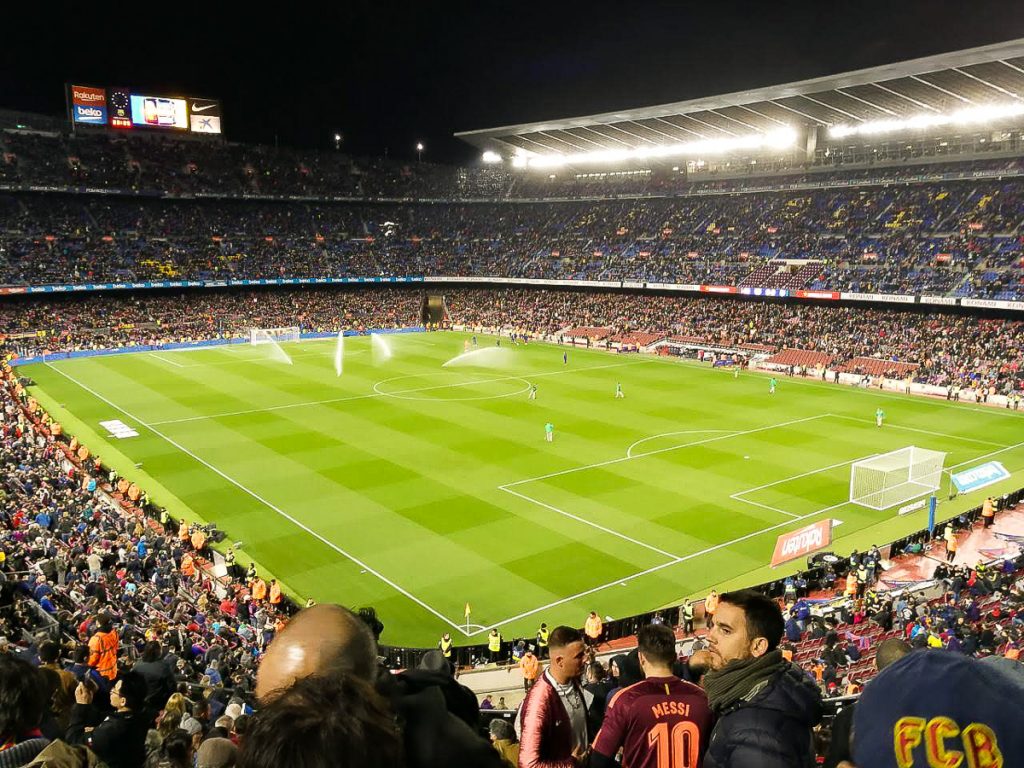
Contributed by Džangir Kolar from Dr Jam Travels
Pilar in Zaragoza
Despite its convenient location right between two of Spain’s most touristic cities, Barcelona and Madrid, Zaragoza is often overlooked by tourists. However, the capital of Aragon has a lot to offer.
Probably the most important of the things to see in Zaragoza is the Catedral-basílica de Nuestra Señora del Pilar de Zaragoza or Pilar for short. This impressive basilica is the city’s most famous landmark. Some visitors even come to the city just to see the unique Pilar with their own eyes.
Pilar was built in the 12th century and is therefore considered the first Spanish church to be dedicated to the Virgin Mary. It is also considered the largest and one of the most important baroque churches in the country.
Pilar’s name (pillar) comes from the fact that the church was built around a column with a statue of the Virgin Mary. You can still see the column inside the famous basilica today. In addition to the statue, there are also other important works of art, decorations, and ornaments to be found inside the church.
But the Pilar is also definitely worth a look from the outside. Whether you prefer to look at it from the Plaza del Pilar at the main entrance to the basilica or from the riverside at the back makes little difference in the church’s beauty.
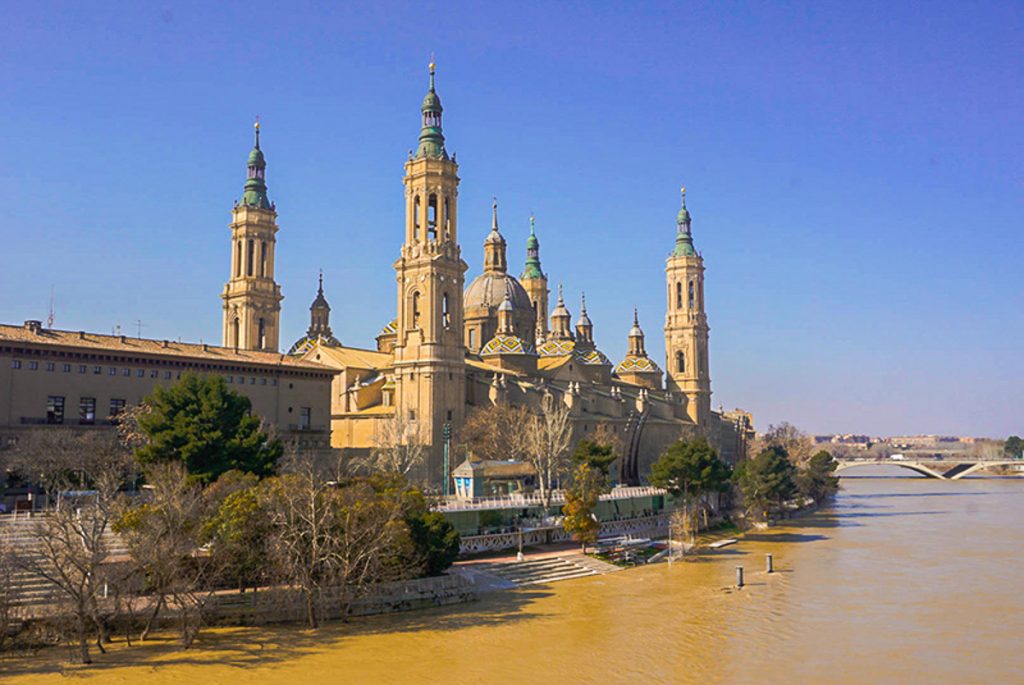
Contributed by Vicki from Vicki Viaja
Landmarks in Spain – Pin it for later




Guggenheim Museum in Bilbao
One of the great things about hiking any of the El Camino de Santiago routes is the fascinating variety along the way. Every trail has its own character and feel. The Camino del Norte runs from Irun, on the Spanish-French border, along the Atlantic coast for roughly 3 weeks before turning inland at splendid Oviedo and heading down to historic Santiago de Compostela.
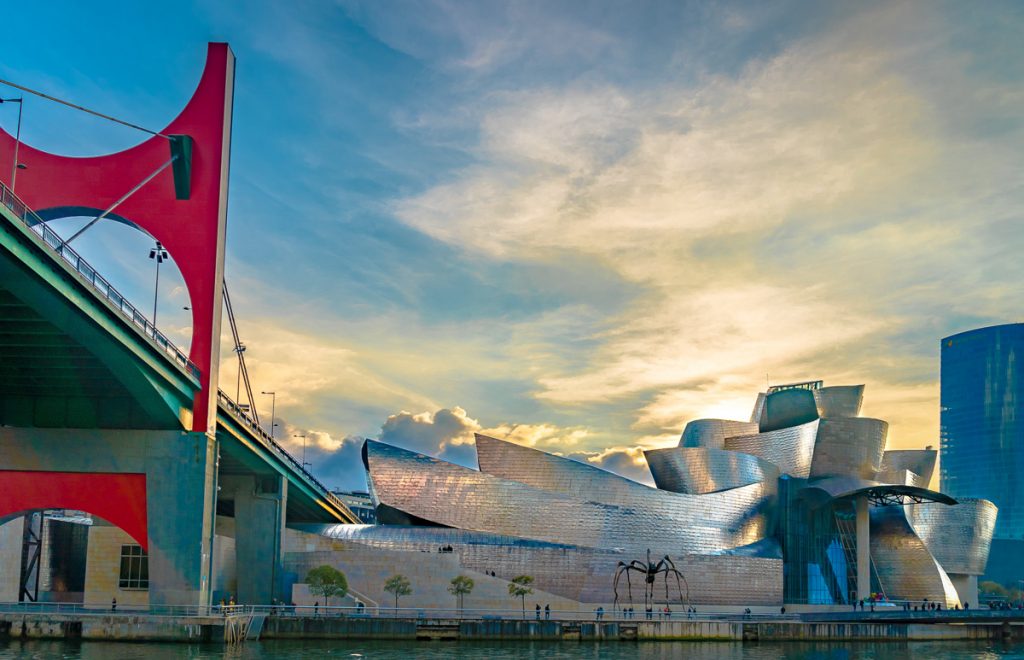
One of the most important stops along the Norte is the wonderful historic city of Bilbao, combining modern beauty with classic architecture and one of the most impressive buildings in the world, the Guggenheim Museum. A Frank Gehry masterpiece, the Guggenheim was designed in 1997 and has been drawing lovers of art and architecture from all over the world ever since. Named in honour of the Solomon Guggenheim Foundation – a famously philanthropic promoter of contemporary art – the entire project cost over €150 million.
While the museum hosts a steady rotation of the world’s top art collections, many people are satisfied with simply admiring the stunning building itself, a huge favourite of amateur photographers from virtually any angle. If you have time, it is worth waiting for the hourly fog show that spreads ominously around the base of the building, adding mood and mystery to the already stunning sculptures. Whether you are an art lover, admirer of outstanding architecture or simply drawn to terrific photo ops, Bilbao’s Guggenheim should not be missed.
Contributed by Dean & Laynni from Routinely Nomadic
The Royal Palace of Madrid (Palacio Real)
The Royal Palace of Madrid is an important symbol of Spain and its fascinating history for so many reasons. This palace is one of the largest palaces in all of Europe, which makes it a wonderful place to explore. The current building of the palace dates back to the 18th century, and the first Spanish king to live in it was Charles III. The magnificent design was inspired by the Louvre in Paris, and the palace has over 3000 rooms.
Tourists are allowed to visit the parts of the palace that are open to the public, for an admission fee. The Royal Place has an amazing art collection and works from legendary Spanish artists like Velasquez and Goya are prominently displayed. One of the most famous pieces in the collection is the only remaining Stradivarius string quartet. The current Royal Family of Spain is part of the Bourbon family, and the symbol of the Bourbons is the lion, so be on the lookout for lions around the palace.
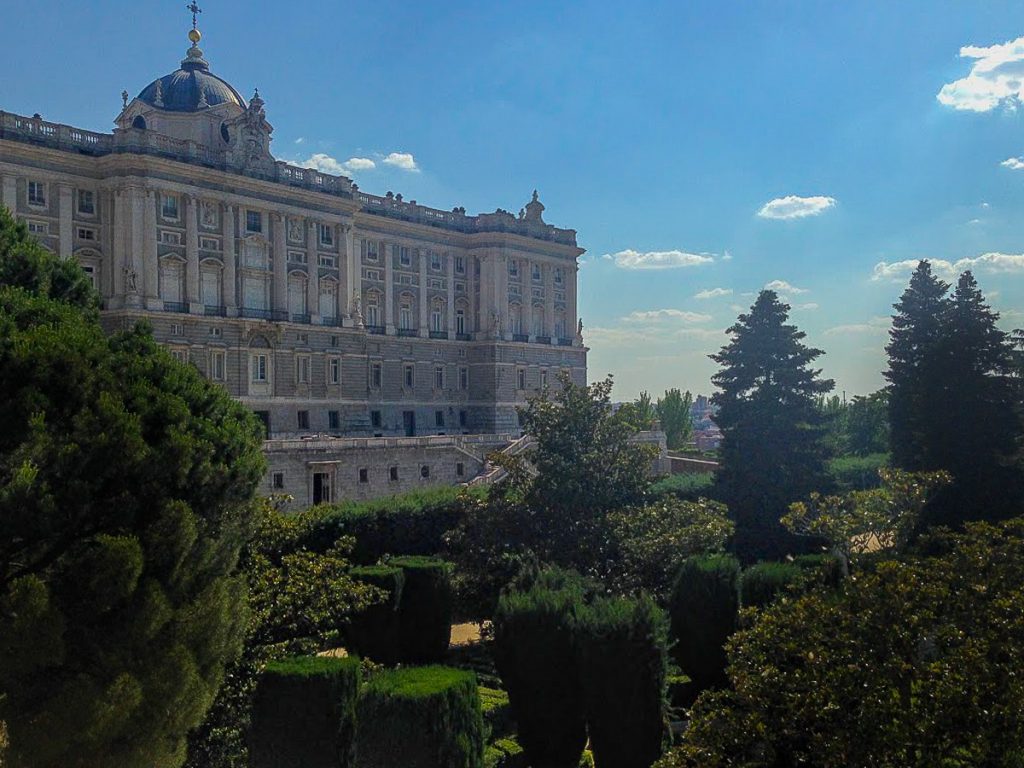
Travelers on a budget can get great views of the palace from the neighboring Sabatini Gardens without having to pay a fee. (And from here, fewer tourists will block your photos of the palace.) The Changing of the Guard on Wednesdays and Saturdays is also most impressive and free to watch.
Even though the Royal Family of Spain no longer lives in the Royal Palace, they still sometimes use the palace to host special occasions, so on those days it will be closed. Check the website in advance to see if the palace is open to visitors on any particular day.
Contributed by Stella Jane from Around the World in 24 Hours
Plaza Mayor, Madrid
Spain Plaza Mayor (Main Square) or more artistically named “the theatre under the skies of Madrid”, originally served as a medieval marketplace (it was called Plaza del Arrabaland). It was a meeting place, above all, for less affluent residents full of street life and now is one of the greatest tourist attractions of Madrid.
In 1619 King Philipe II decided to change the street market to the city’s most representative place, which became the heart of the city. over the years Plaza Mayor was a backdrop for important historical events, such as coronations, royal speeches, and even executions.
Nowadays the enormous (129 m x 94 m, 423 ft x 308 ft) Plaza Mayor is a tourist attraction full of street life, where locals and tourist come to walk around, have coffee, eat or just enjoying outdoors.
If you are in Madrid and If you are a Real Madrid fan you should visit the Santiago Bernabéu Stadium. Another interesting landmark in Madrid is Plaza de Espana with Torro de Madrid one of the tallest building in the city.
Museo del Prado, Madrid
Being the capital city of Spain, Madrid has a great deal of history and regality that manifest while you are strolling along the streets from government buildings, cathedrals, monuments, and palaces. Art museums are of course also in the reign, while Prado Museum is frequently voted as the most popular attraction in Madrid, the museum is also named one of the most prestigious classical art museums in Europe, at the same rank as Le Louvre in Paris and the National Gallery in London.
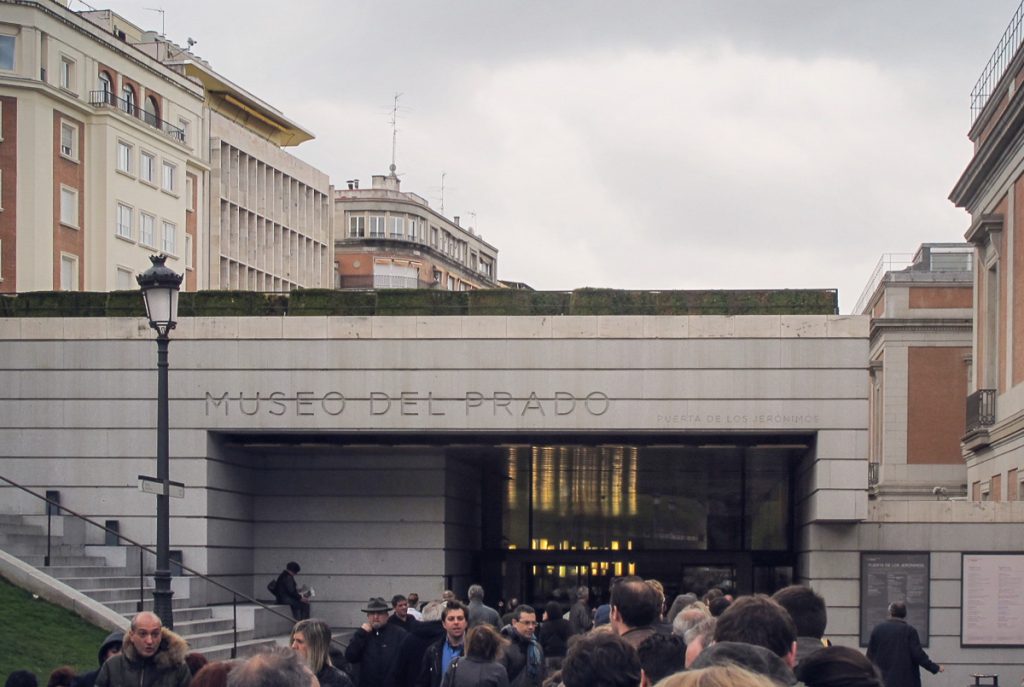
Museo del Prado, or in short, Prado, is in the heart of Madrid alongside El Retiro, a historic park that once belonged to the Spanish Monarchy. The museum is also part of the Golden Triangle of Art; together with Thyssen-Bornemisza Museum and Reina Sofía Museum, they showcase European artworks in many different genres and eras, inspiring tens of thousands of art lovers and students who visit these premises every day.
The three museums house an exciting number of world-class masterpieces in their collections. Prado mainly focuses on the classical art of great Spanish artists including El Greco, Velázquez, Goya, and Rubens, along with other famous international artists. No visit to Madrid is complete without seeing Las Meninas, the Naked Maja, or The Garden of Earthly Delights, these are some of the most important paintings in Spanish history.
Tourists may enjoy free access to these museums with a Madrid Card, it will save time as there is always a long queue at the ticketing office. Do not forget to stop by the Caixa Forum on your way from Prado to Reina Sofía; it is an urban renewal project featuring some cool architectural details.
Contributed by Knycx Journeying
El Escorial
Outside Madrid, just one-hour driving, you will find El Escorial, a beautiful castle-monastery erected in the 16th century. Being so close to the capital city of Spain makes it a perfect location for a day trip. From Madrid, you can get there by train or by car. If you come by car from Avila to El Escorial you will enjoy a perfect view of the monastery. A big parking lot just in front of the attraction makes it really accessible for those who arrive here driving. From the train station, you must walk around 20 minutes through the park. The complex of buildings called El Escorial is not accessible for wheelchairs or strollers because inside you must climb and descend a lot of stairs. We visited it with our 1-year-old baby so we had to carry him since the stroller was not an option.
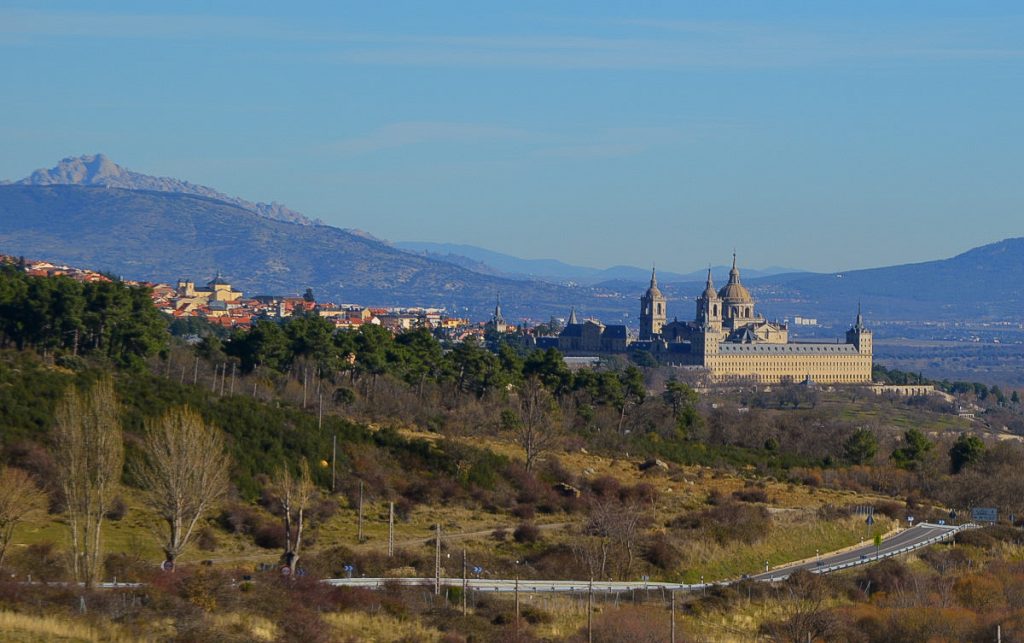
Once you are there, you will need around half a day just to explore the place. Start with the library and pay attention to the hidden details inside it. Continue your visit with the 2 palaces (Bourbons and Felipe II) and don’t forget to enter the basilica. You will receive a map at the entrance to find each place. In the end, descent of the stairs to see where the kings of Spain and other royal family members are buried. I think that the kings’ tombs are the most interesting part of the complex. For mystery lovers probably the library is a gem: around 40000 books and manuscripts are kept here among colorful paintings, scientific instruments, and hidden symbols.
Contributed by Corina from Another Milestone
Artes y las Ciencias Valencia
The City of Arts and Sciences in Valencia is the newest Spanish Landmarks. The building is an architectural complex designed by Santiago Calatrava into few areas
- The Hemisfèric with Imax cinemas and laser show
- The Museu de les Ciències with one of the best Science Museum in the World
- The Oceanogràfic with one of the biggest Aquariums in the world
- Palau de Les Arts, an oval-shaped auditorium with a concert hall
- Agora: multifunctional space for holding events
- Umbracle – the garden


Spain Landmark – Avila
The World Heritage, intra-muros town Ávila in Spain could be considered as a traditional Spanish city. Ávila is surrounded by its formidable walls, which are known as Murallas. These medieval walls provide a fortified safety ring to the old town, hence allowing the town to enjoy the comfort and safety. These 2.5 km stretch and more than three meters thick Murallas or walls are considered among the finest city defences in the world.
The iconic town was developed after Avila was conquered back from the Moors to stand as a fortress against the Caliphate. The walls are standing on top of the remains of earlier Roman and Muslim ramparts. The town flourished from then and never looked back.
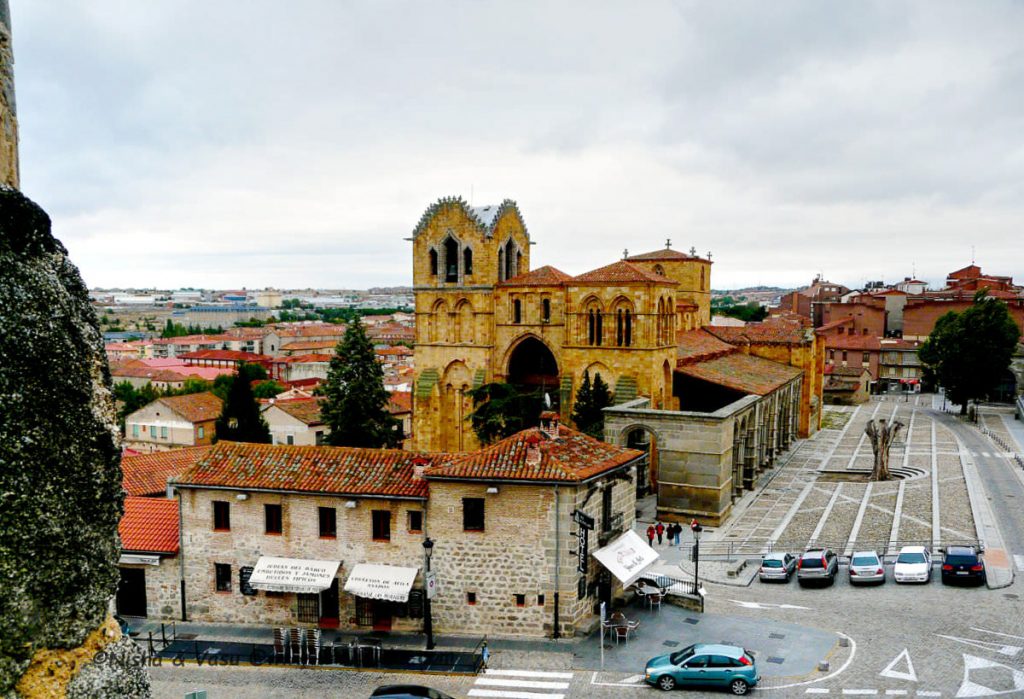
Ávila is the birthplace of Saint Teresa and hence the pilgrims also flock to Ávila.
The magnificence of Avila is reflected in the Romanesque style of the churches and the architecture of its convents and monasteries. There are many things to do in Avila. First, to take a walk around the old city walls is a must, passing through its arches and gateways. The Cathedral of Avila is one of Avila’s oldest religious buildings, and represents the finest Gothic architecture in Europe.
One of the museums which should not be missed is Cathedral Museum. It has a large collection of extremely valuable artefacts including tapestries and embroidered pieces. Another museum of importance is Museum of Oriental Art showcasing ivory carvings, wonderful metalwork
Souvenir shopping is not completed if you don’t buy Yemas de Avila, a Spanish confectionary. Gazing down at the city from a vantage point to the west, Ávila looks like a place out of a storybook or fantasy world.
Contributed by NISHA & VASU from Le Monde, the Poetic Travels
Aqueduct in Segovia
If you have a penchant for fairy-tale towns and cities, then you’ll adore a visit to Segovia. The city’s most iconic landmark is the Aqueduct of Segovia or El Aqueducto. Some fascinating stories are surrounding how the Aqueduct got here, some say it was built by Hercules, and others say it was the Devil! However, it was the Romans that built around the 1st century AD.
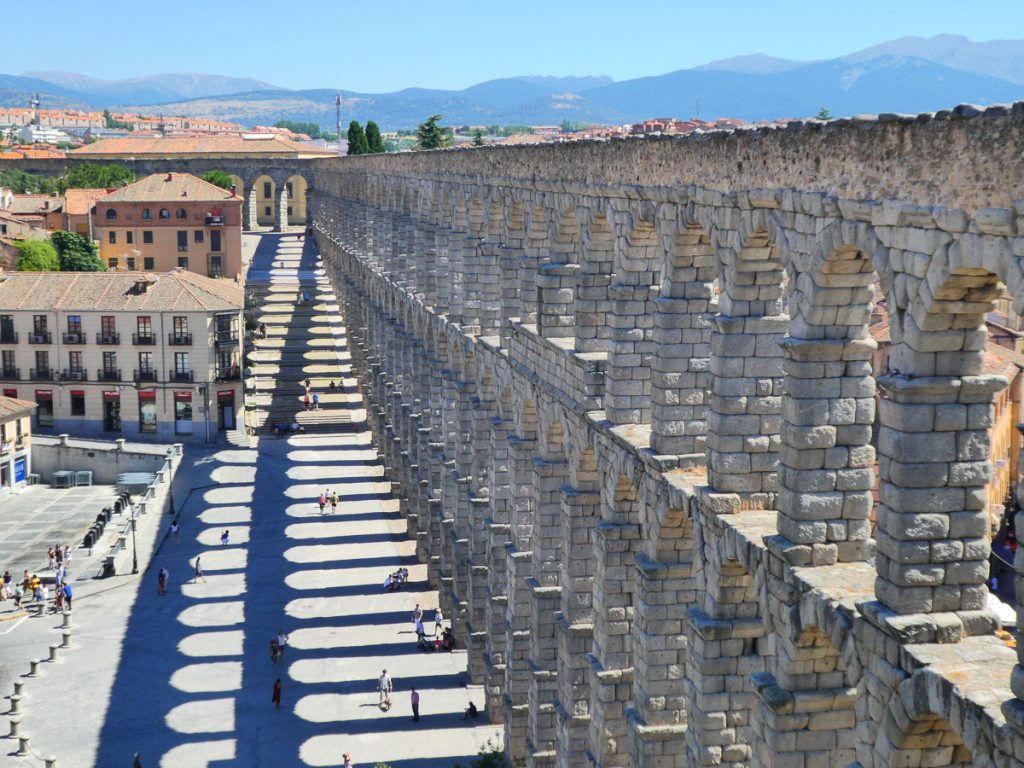
Some fascinating facts about the Aqueduct are that it’s been built without the use of mortar, it just gravity that holds the gigantic structure together. The Aqueduct still works to this day and brings freshwater to the town. It’s so important that it’s also the symbol of the city, so you’ll find little motifs of the aqueduct everywhere.
Other notable things to see in the pretty UNESCO listed city are the Alcazar of Segovia, which looks like Disney’s Magic Kingdom with its pretty tower and turrets. There’s also the Gothic Cathedral of Segovia in the centre of the city. Other interesting places are the old Jewish Quarter and the old city walls. If you have the time and enjoy walking, there is a Mirador which gives a beautiful view of the city from outside the walls.
Contributed by Becki from Meet Me In Departures
Santiago de Compostela Cathedral
The Cathedral Santiago de Compostela is probably the most significant religious attraction in Spain. It’s one of the three known churches in the world built over the remains of an apostle of Jesus. The tomb with what’s believed to be the remains of Apostle Saint James was discovered in 814AD. Constructions of the current Cathedral started in 1075 and continued throughout the following centuries till the 18th century when the building got its last additions. Both the exterior and interior of the Cathedral are truly stunning. One can spend hours observing its elaborate facades, columns decorated with sculptures of saints, arches with scenes from the Old Testament, and of course the spectacular altar of the Cathedral.
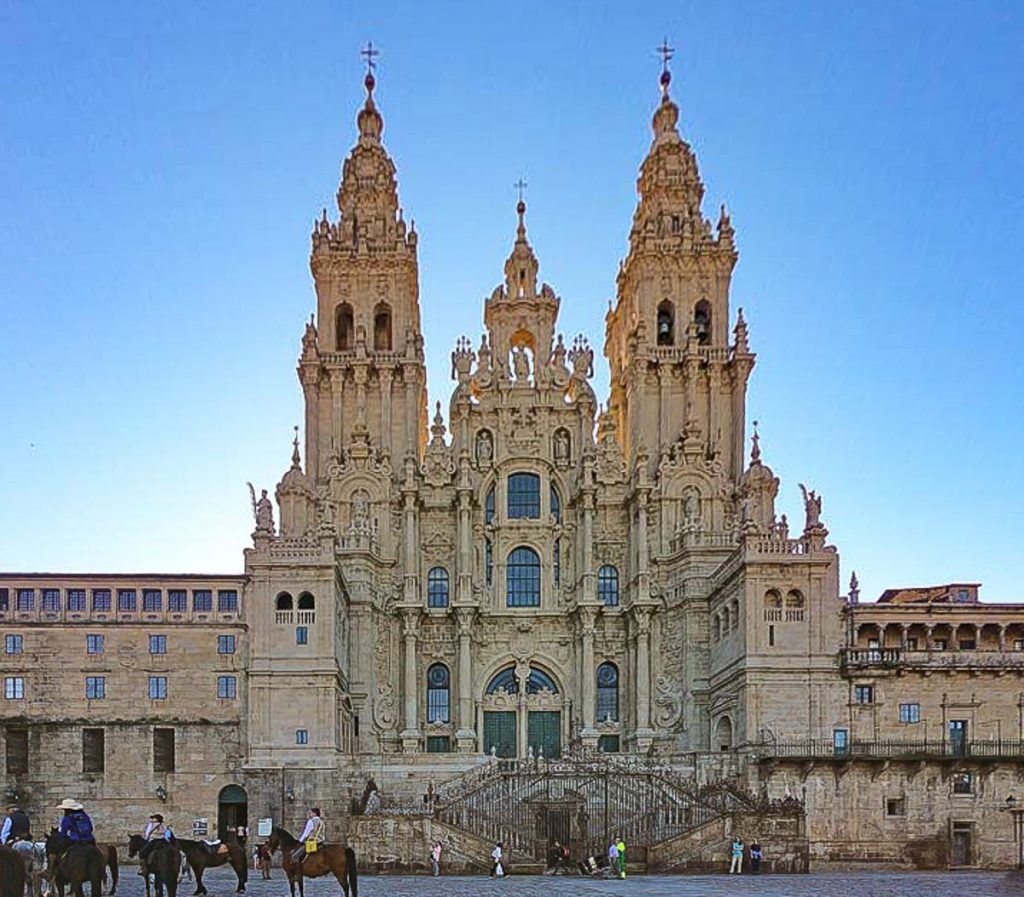
Since the early Middle Ages, the Cathedral has been playing an important role in the Christian culture. Soon after the discovery of the tomb of the saint pilgrims from Europe on foot or on horses started arriving in Santiago de Compostela following the route that is known as the Way of St.James. Nowadays hundreds of thousands of pilgrims from all over the world finish their pilgrimage at the Cathedral every year.
The best time to visit the Cathedral of Santiago is during the famous Botamufeiro ceremony that takes place several times a year on special religious occasions such as Christmas, Resurrection Sunday, etc. The entrance to the Cathedral is free. Tourists are not allowed inside during daily masses though anybody who wants can join the service.
Contributed by Alya from Stingy Nomads
Real Alcazar de Sevilla
Discovering the architecture in the Andalucia region is one of the most interesting things to do in Spain and there is no better place to do that than at the Real Alcazar de Sevilla. The Royal Palace is a UNESCO World Heritage Site built over 700 years ago that showcases various different styles of architecture and garden design from Mujedar and Moorish features to Baroque and Renaissance. This collection of styles combine to make an enchanting fairy tale location.
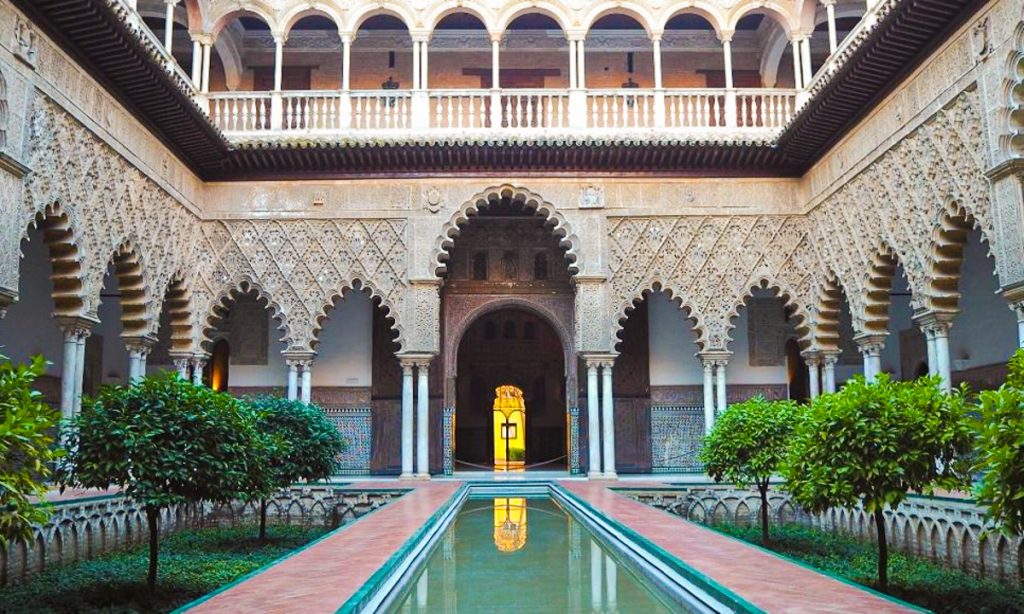
Perhaps the best known part of the palace is the Ambassadors’ Hall or Salón de Embajadores covered in elaborate tiles and topped by a domed roof. This beautiful room has hosted royal weddings and other state occasions. You can wander from room to room admiring the various styles of decoration including majolica tiles and intricate carvings and tapestries.
Outside, the palace is no less magnificent. You can wander the vast grounds and admire its vast estate of ornate ponds and gardens. This stunning complex is one of the best things to see in Seville and you’ll need to allow several hours to take it all in. And if you think it looks familiar, then know that is was used as a filming location for Lawrence of Arabia and Game of Thrones.
Plaza de España
Plaza de España (The Spanish Square) that is part of the Parque de Maria Luisa. It is an impressive square surrounded by horseshoe-shaped galleries. The entire complex was built for the Iberian-American Exhibition in 1929, and its author is Aníbal Gonzalez. What stands out are not only the water features, but the beautiful four bridges that symbolize the kingdoms of Castile, León, Navarra and Aragon. The work itself is a building with benches and walls decorated with ceramic tiles called azulejos. They are a real history lesson and present the 48 Spanish provinces in alphabetical order with the most important events in their history.
An interesting fact is that Plaza de España was used in films. Plaza de Espana “played” the planet Naboo in the movie “Star Wars – The Phantom Menace”,
Katy Clarke from Untold Morsels
Seville Cathedral, Sevilla
The Seville Cathedral started off as a mosque but was converted into a church after the Spaniards conquered Seville from the Arabs. It is one of the most impressive landmarks in all of Spain, and visiting the cathedral is one of the top things to do in Seville. It is the largest Gothic church in the world and the sheer size and details in the architecture will have your mouth hang open as you explore the cathedral.
Walking through the gigantic inside of the cathedral, you will move from dark gothic chambers to bright chapels with vaulted ceilings. Keep an eye out for Goya paintings. The golden ceiling in the main nave, the altar and the enormous organ are sure to catch your eye too.
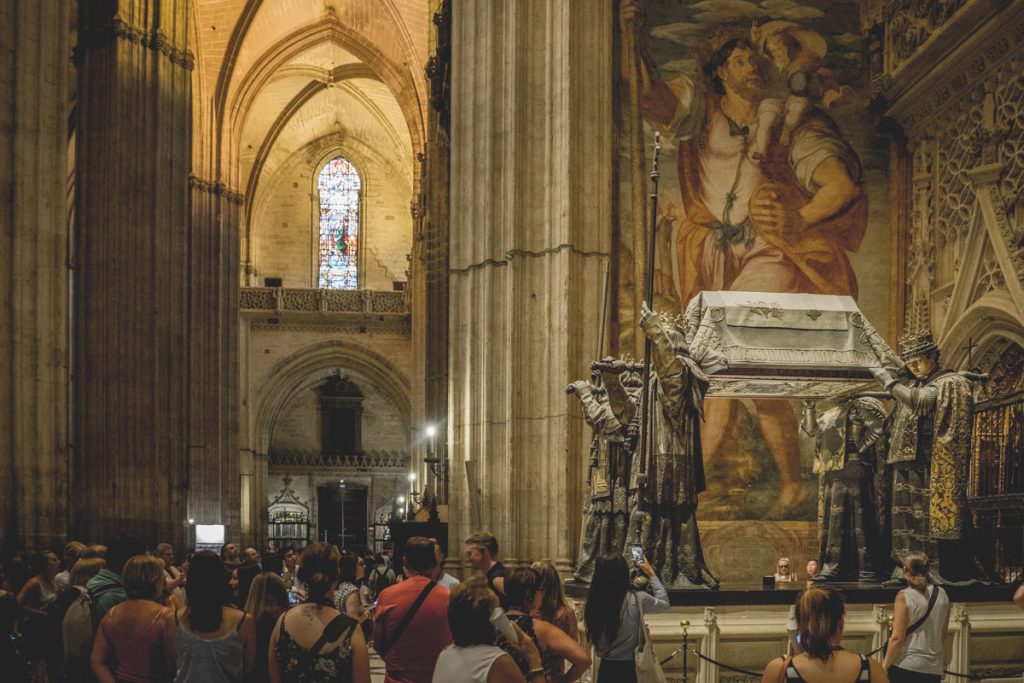
The Seville cathedral is also the final resting place of Christopher Columbus. After falling out with the Spanish Royals, Columbus made it clear that over his dead body would he be buried on Spanish soil. For this reason his remains are held up in the air by 4 figures, above the ground.
After seeing the inside, climb up the Giralda tower for a bird’s eye view of the cathedral’s roof and buttresses, as well as an amazing panorama over Seville. Like the cathedral, the Giralda started off as a minaret but was converted to the bell tower after the Reconquista.
Before leaving the cathedral, spend some time relaxing under the famous Seville orange trees in the courtyard.
Contributed by De Wet & Jin from Museum of Wander
Italica
Many cities boast ruins. Ruins that have an epic story behind them, one of victories, conquests, life and death. The ruins of Italica, just out of Seville holds even more stories. It is the birthplace of two Roman Emperors, Trajan and Hadrian and more recently, it was chosen as a film set in the Game of Thrones making this settlement from the 2nd century BC a must-see when staying in Seville
Located just 10km’s out of Seville you can either take the public transport out to the site or you can easily take a taxi. There is a bus stop just a few meters from the gates but bus times can be staggered. If you do plan to use public transport make sure you keep track of the times and plan your trip to Italica accordingly.
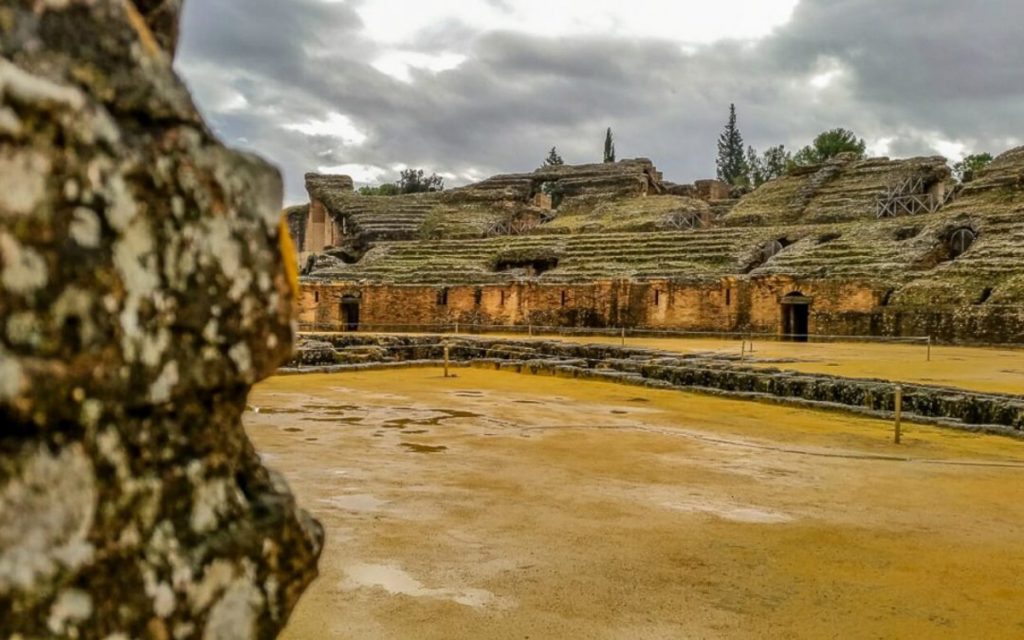
While this site was chosen to house veterans from the war with Hannibal and the Carthaginians it was still a bustling metropolis in its day. It has sections of the ruined town where you can see the beautiful mosaics that were on the floor of the homes there and the gardens that all Romans seem to have in a courtyard. The tree-lined stone streets are rough and well worn, a testament to how well Italica was established.
But the one thing in Italica that will completely amaze you is the Amphitheatre. The Amphitheatre at Italica is believed to be the 3rd biggest Colosseum in the Roman Empire and in it’s prime could hold up to 25,000 people. Stepping out into the centre you wonder what sort of entertainment was helped here and what the atmosphere would have been like when it was full to the brim with people.
There is not a lot of information around the town itself but there is a small museum when you first enter the site which is well worth a look. You can find out how the ruins were found and other artefacts they have found at the site over the years. You can also pick up a small information pamphlet when you pay your entry that is in English.
The walk around this site is amazing and you can spend a few hours back in the days of the Roman Empire.
Explored by Bec from Wyld Family Travel
Puente Nuevo – Ronda
Puente Nuevo is without a doubt the most iconic landmarks in Ronda, connecting the city across the 120 meters deep Tajo Gorge. The hillside town is an easy day trip from Seville or Malaga, but if you have the chance to stay longer, there are plenty of hotels to choose from, even with an exclusive view of Puente Nuevo. The bridge was built over 40 years and by the time it was finished in 1793, a terrifying number of 50 workers had lost their lives in the construction. Puente Nuevo means “new bridge” and it is the newest and biggest of three bridges spanning across the gorge. It was built to improve accessibility between the market place and the rest of the city. The first attempt of building a bridge across this part of the gorge had gone terribly wrong as the bridge collapsed and killed a large number of inhabitants. As a result, the new architect, Domingo Lois de Monteagudo created the sturdy, beautiful design you see today. To get the best views and pictures of the Puente Nuevo bridge, walk the trail down to the bottom until you find yourself in front of the bridge and the waterfall running down beneath it. You can also walk a narrow path along the right side of the ravine to experience the bridge from beneath and from the other side. But it is not well maintained, so you need to be careful.
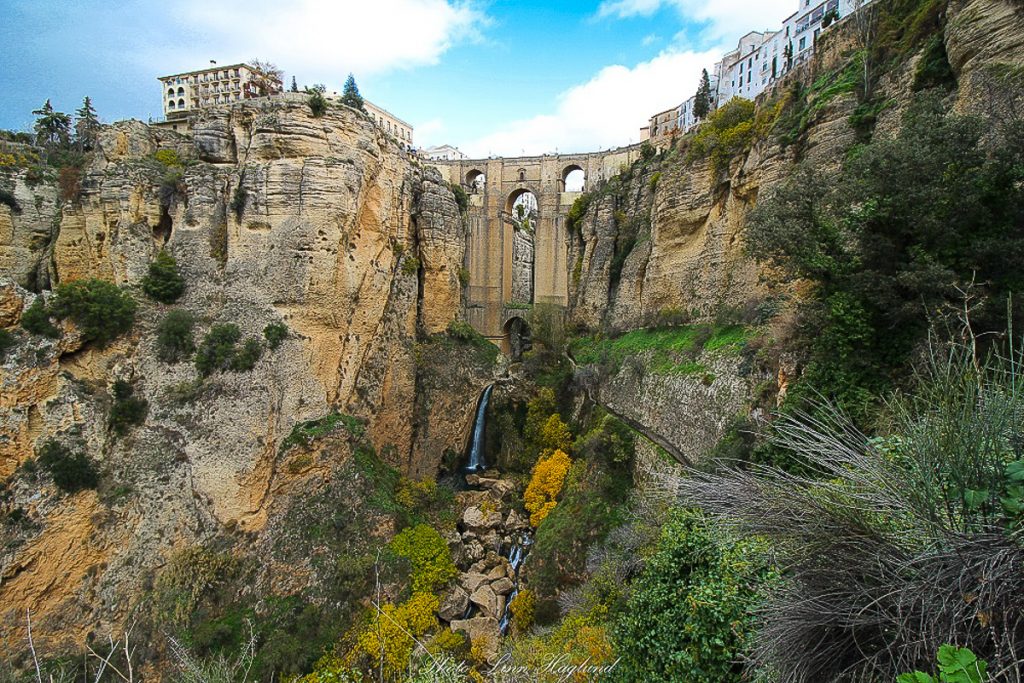
Contributed by Linn Haglund of Brainy Backpackers
The Alhambra of Granada
If you are planning a trip to Andalusia, Spain’s beautiful southern province, be sure to include the Alhambra of Granada in your itinerary for Andalusia! Exploring the iconic Alhambra is one of the top things to do in Granada.
The palace and fortress complex was originally built in the 9th century on top of the remnants of an old Roman fort. It was rebuilt in the middle of the 13th century by the Nasrid ruler of Granada, who added the beautiful palaces that you can see today. In the 14th century, the Sultan of Granada made the Alhambra the official palace.

After the Reconquista, Ferdinand and Isabella used the Alhambra as their Royal Court, and made some Renaissance-style modifications to the palace. In the 16th century, Charles V ordered the building of a new Reniassance Palace, which was never fully finished but can be viewed in the complex.
The Nasrid Palaces are the most beautiful parts of the complex, with the lacelike Mudejar architecture, the famous Courtyard of the Lions, and ornate designs and decorations. They can be entered only on a time slot stamped on your ticket, so make sure you are there in plenty of time!
The rest of the complex is also worth touring, as many areas have stunning views over the city of Granada. The adjoining Generalife Gardens are also gorgeous, especially when in bloom in the spring and summer.
The Alhambra is the most popular attraction in all of Andalusia, so buy skip-the-line tickets or book a guided tour well ahead of your trip. There is a limit on the number of visitors allowed per day.
Contributed by Dhara from It’s Not About the Miles
El Caminito Del Rey
If you visit Spain there is no better place to explore than El Caminito Del Rey.
El Caminito Del Rey is within the province of Malaga and was once considered one of the deadliest paths to walk in the world. Unfortunately, the old path was too dangerous and people died walking it. Thankfully, today, that has changed and you can safely enjoy the picturesque views the walk has to offer.
It is situated within the gorge of El Chorro, with newly built walkways on the edge of cliffs. As you walk along the paths you are presented with jaw-dropping views within the gorge. If you can brave to look down, you can see valleys and reservoirs which is complemented with beautiful views of the mountains.
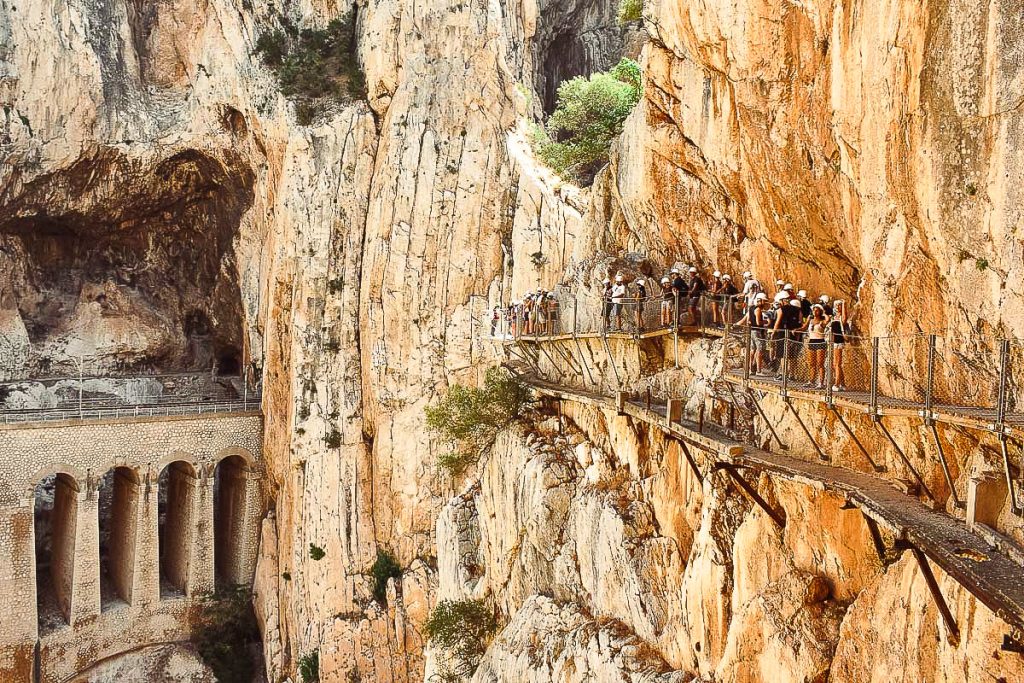
One thing to note is that the walk is only one way so you cannot loop back on yourself. However, at the end of the walk is a shuttle bus service which will take you back to the beginning. El Caminito Del Rey can be easily accessed from Malaga by train. This makes it easy to take a day trip and saving the hassle of renting a car if you don’t already have one.
If you speak to anyone with a bucket list of things to do in Spain, El Caminito Del Rey is sure to be on it. Make sure you don’t miss this historic spot.
Contributed by Kerrie & Woody from Just Go Travelling
Mezquita Cathedral in Cordoba
Mezquita Cathedral in Cordoba is an interesting landmark, a place of wonder. It provides a very unique perspective; how the most beautiful, intricate architecture could be so ugly in the wrong place!
It’s proper name is Cathedral of Our Lady of the Assumption (Spanish: Catedral de Nuestra Señora de la Asunción)
It started off as a Visigoth church (disputed) which was then bought my the Moors to build a rather simple mosque. Over the years the mosque was expanded by many Emirs until it got to its current size. Spain, then got conquered back by the Christians who looked at the building with positive disgust so they to rebuild it as a cathedral. On its completion King George V said his famous words, ‘You have destroyed something unique to build something commonplace’.
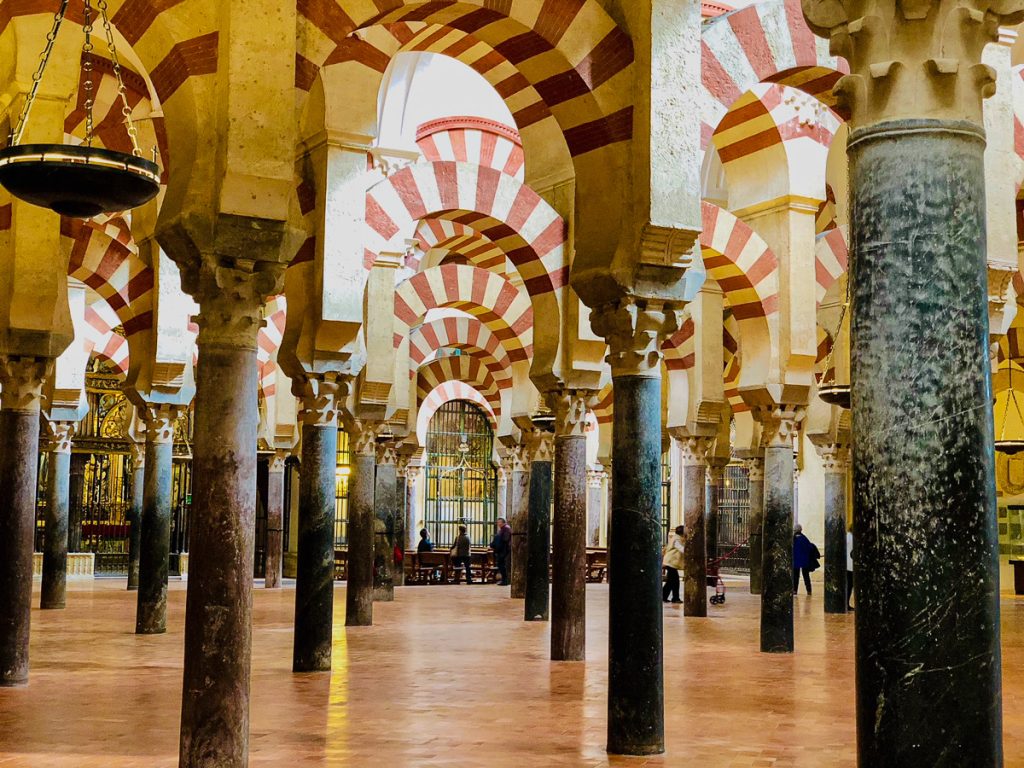
It is a must visit spot in Spain because it still retains its former glory and majesty. The entrance fees can be found on the official website .
The building is a courtyard full of orange trees followed by the vast building which is lined with beautiful iconic arches. The nave of the cathedral stands right in the centre of the building. Most of the features of the buildings Islamic past are still there from the Arabic verses and geometric designs intricately etched into the walls in the form of arches. You don’t even need to enter to see this, the doors outside the building are the same.
The last look on this beautiful building should be from the Roman Bridge of Córdoba behind the building which does make you realise the grandeur and size of this icon of Andalusia.
Contributed by Ucman from BrownBoyTravels
Famous Spanish Landmarks – Pin it for Later !!!




Privacy Policy Disclaimer
This website uses affiliate links for income and support.
If you like our website, please consider using these links. You will be directed to the vendor, and we will get a small commission on your purchase price at no increased cost to you.
We have researched facts stated here as far as practicable but please check anything critical before committing your time and money. We do not claim any special knowledge or expertise, and we are not consultants for our readers.
